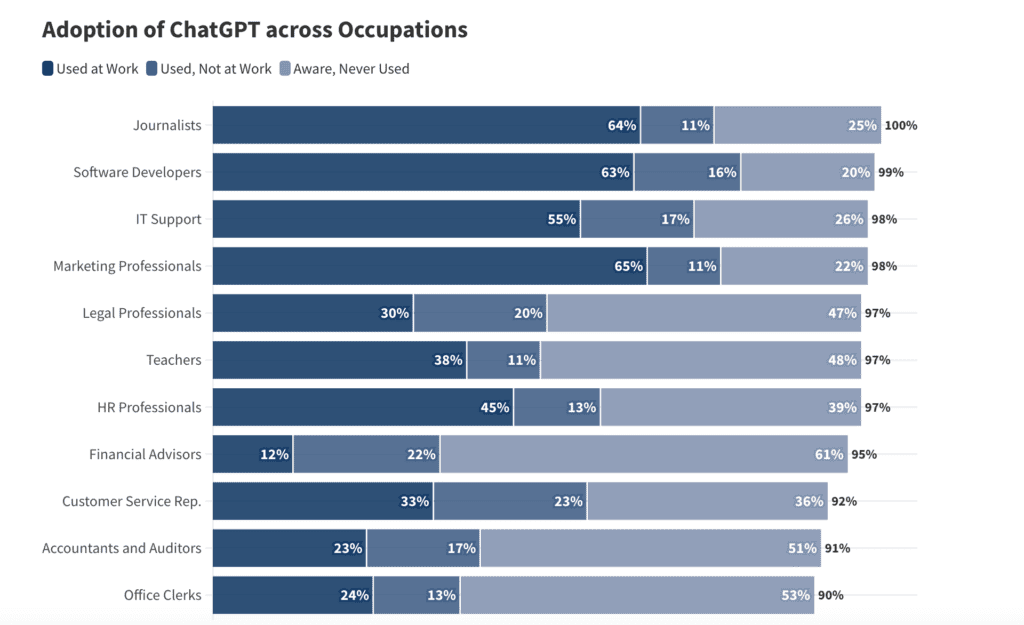Artificial Intelligence (AI), particularly AI chatbots like ChatGPT, has ushered in a new era of technological interaction. These sophisticated models, capable of understanding and generating human-like text, are transforming the way we communicate, work, and learn. The rapid adoption of AI chatbots, especially ChatGPT, across various domains and age groups—ranging from businesses enhancing customer service to educators offering personalized learning experiences—demonstrates their potential to reshape industries and daily life.
AI chatbots are not only changing how individuals interact with technology but also bridging generational gaps in technology adoption. While younger generations, such as Millennials and Gen Z, are more likely to use these tools for social interaction, entertainment, and learning, older adults are gradually embracing chatbots for practical purposes. This widespread appeal of AI chatbots across age groups signals their potential to create a more inclusive and connected digital world.
AI Chatbots in the Corporate Sector: Improving Efficiency and Personalization
In the business sector, companies are increasingly leveraging AI chatbots, particularly ChatGPT, to enhance customer support, streamline operations, and deliver personalized experiences. The focus on improving user experience through AI chatbots highlights the growing priority that businesses are placing on meeting the evolving needs and preferences of both customers and employees.
A recent study from the University of Chicago explored the spread and impact of ChatGPT in professional settings. Conducted between November 2023 and January 2024, the research examined the adoption and impact of AI chatbots across various industries. The study surveyed 100,000 workers across 11 occupations exposed to ChatGPT, gathering both qualitative and quantitative data on usage patterns, attitudes toward the technology, and barriers to adoption.
Key Findings: Occupation-Based Usage and Gender Disparities
The findings from this study reveal interesting trends in ChatGPT usage across different occupations and genders:
- High Adoption in Tech-Related Jobs: Occupations like software developers, journalists, and IT professionals exhibited the highest adoption rates of ChatGPT, with over 50% of workers in these fields using the AI chatbot in their daily tasks. Software developers had the highest adoption at 79%, followed by journalists and IT support professionals.
- Lower Adoption in Traditional Roles: In contrast, traditional occupations such as office clerks, financial advisors, and customer service representatives had much lower adoption rates, highlighting a divide in how different sectors are integrating AI chatbots into their workflows.
- Generational Differences: The likelihood of using ChatGPT is higher among younger, less experienced workers. The study found that the adoption rate decreased by 1 percentage point per year of age, with younger professionals more inclined to embrace this technology. Additionally, individuals with higher levels of education and better job performance were more likely to use ChatGPT, which correlates with higher incomes and greater overall success in the workplace.
- Gender Gap: The data also revealed a significant gender disparity, with female workers using ChatGPT 20% less than their male counterparts. This gap persists even within the same occupations and workplaces, suggesting that factors beyond job responsibilities, such as training or cultural barriers, may influence technology adoption.
Barriers to Adoption: Privacy, Training, and Policy Restrictions
While ChatGPT has proven to be a valuable tool for many professionals, several barriers prevent broader adoption, particularly among women and less experienced workers:
- Restrictions on Use: Both women (30%) and men (41%) cited restrictions on use—such as company policies or regulatory compliance—as a major obstacle to adopting ChatGPT. These restrictions may relate to concerns about data privacy or the misuse of AI tools within the workplace.
- Need for Training: A significant number of respondents, especially women (48%), identified lack of training as a barrier to using ChatGPT effectively. This suggests that more educational resources are needed to help workers, particularly women, become comfortable with AI technology and maximize its potential.
- Data Confidentiality Concerns: Privacy remains a critical issue, with 26% of women and 31% of men expressing concerns about the confidentiality of the data shared with AI chatbots, indicating that security protocols must be strengthened to encourage adoption.
- Lack of Existential Fears: Interestingly, few workers cited existential fears—such as concerns about job displacement due to AI—as a major deterrent to using ChatGPT. This suggests that, while there are privacy and usability concerns, workers are not generally worried about AI replacing human jobs.
Potential for Increased Adoption and Future Implications
The study suggests that there is significant potential for increased adoption of ChatGPT across various sectors. By addressing the barriers identified—such as training gaps, privacy concerns, and restrictive policies—organizations can enhance the integration of AI chatbots into their operations. Encouraging wider usage could result in productivity gains, particularly if companies restructured their processes to more effectively incorporate ChatGPT.
Moreover, governments and organizations can play a crucial role in promoting AI adoption by providing educational resources, policy adjustments, and training programs that specifically target underrepresented groups, such as women and less experienced workers. This approach could help bridge the existing gender gap and ensure that the benefits of AI chatbots are more evenly distributed.
Conclusion
The rise of AI chatbots, especially ChatGPT, marks a significant shift in the way technology is integrated into the workplace and beyond. As this technology continues to evolve, its potential to enhance productivity, foster inclusivity, and bridge generational divides will become even more pronounced. However, overcoming the barriers to adoption—especially related to training, privacy, and policy restrictions—will be essential to ensure that the benefits of AI are accessible to all workers, regardless of gender, experience, or occupation.






